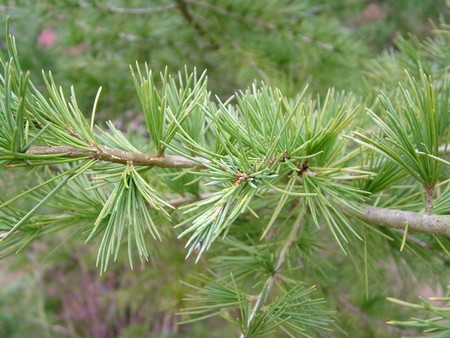Larch is a conifer which is indigenous to hilly areas throughout Central Europe where it can be found in large forests. It was introduced into England in 1639 for its enormous value in housing and shipbuilding. The wood is stronger and more durable than most other conifers, and is almost indestructible by fire. The Romans used it in building castles, which were often apparently almost impossible to destroy in sieges. Augustus used it for building the Forum in Rome and Tiberius found it very useful for making bridges. Larch is also valuable because it grows so quickly – six times faster than oak; some of the beams of larch found in houses in Venice are over 100 feet (30 metres) long. As a result, larch has been worshipped in many parts of the world as a symbol of immortality and incorruptibility, also of boldness and audacity. It has been used to protect against evil influences, witchcraft and disease.
The larch is not evergreen like other conifers and the appearance of its bright green leaves in spring symbolized renewal of life, regeneration of energy, death and rebirth. Large amounts of its resin, turpentine, are collected from larch trees when they are fully grown and has been used for centuries in medicine and for making varnish, when it is known as Venice turpentine – it used to be exported exclusively from Venice. The resin and sap were regarded as the soul of a tree, a source of fire and regeneration. Resin represents immortality and the undying spirit. Larch is said to be ruled by Mars.
Herbal remedy
Larch is mainly used as a stimulating expectorant for catarrhal coughs and bronchitis. Its astringent properties can be put to good use in treating heavy periods, diarrhoea and bleeding. As a diuretic, larch can be taken to relieve fluid retention and to aid elimination of toxins via the kidneys. This makes it a useful remedy for arthritis and gout. A weak decoction makes a good eyewash for inflammatory eye problems and a lotion for skin problems such as eczema and psoriasis, as well as piles and varicose ulcers. Larch has also been used to lift the spirits and dispel melancholy and despondency.
Externally, the turpentine can be used in compounds to apply to rheumatic joints and gout. The new twigs and bark can be boiled and employed as an antiseptic inhalant for catarrh and respiratory infections. Turpentine was used in the past in massage oils in cases of paralysis and in hospitals to stop the onset of gangrene.
The flower essence
The Bach Flower Remedy larch is again used to dispel melancholy and despondency that arises from a sense of failure and inferiority. A larch person suffers from lack of self-confidence, and an inbuilt, almost unconscious, feeling that they are less able than others. This means that they often do not attempt to do things, convinced as they are of failure. They deprive themselves of opportunities in life and the chance to live life to the full. The more such people think they cannot do things, the more they fail in their self-fulfilling prophesy and hence a vicious circle is created. They feel increasingly useless and impotent.
Larch people are not resentful or jealous of others’ abilities, admiring others for their successes in matters a larch person would never even attempt. In fact such people are usually just as capable as others, despite their modesty.
The larch flower remedy can be taken to help dissolve negative ideas of oneself from the past that are inhibiting proper development and fulfilment. It can be used for adults and children alike. It enables one to recognize otherwise hidden abilities and to increase self-confidence and self-esteem, making it particularly useful during periods of challenge such as exams, and for children venturing to do things for themselves, such as homework, without parental assistance. It helps one to persevere despite setbacks and to tackle projects with a more positive or open attitude about the outcome.
